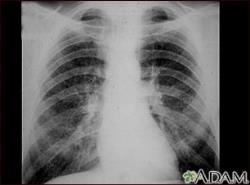NPR Story Highlights Four Important Studies About Resurgence of Black Lung Disease

X-ray Showing Simple CWP, Category 2
Yesterday, NPR published another article in its series on the recent resurgence of black lung among American coal miners.
The piece by Howard Berkes (with help from Benny Becker) covers recent medical research discussed at the annual conference of the American Thoracic Society, one of the leading medical organizations for lung specialists.
Four recent studies are mentioned that add significantly to the body of scientific evidence about black lung. Each of these studies warrants attention, especially as the final versions are published in the coming months.
The most striking finding is one from a study that was being discussed even though it has not been published or formally presented. As the NPR article explains, “a shocking 20 percent among tested working miners in central Appalachia who have worked 25 years or more” are showing early stage black lung according to NIOSH’s surveillance program. As a point of comparison, as recently as 2011, NIOSH’s official data showed that 5.4% of coal miners around the nation with 25+ years of experience had black lung. And even in the central Appalachian region, the rates reported in 2011 were 9% to 13.2%. The recent data showing “1 in 5 veteran working coal miners in the region could have diseased lungs” represents a doubling of the disease in less than a decade.
The reality of 20% of career Appalachian coal miners’ having black lung is staggering. Considering the tens of thousands of coal miners who worked for decades in Appalachia, this means that the number of those miners with black lung is thousands higher than previously thought.
In 2014, I worried that the data showing an increase in the severe form of black lung known as PMF was “the tip of the iceberg.” But as the Titanic shows, even knowledge that an iceberg exists does not tell you what is hiding underwater. The report of this forthcoming study suggests that the rest of the iceberg is huge with devastating impacts for coal-mining families and their communities.
The other three studies are also striking.
Two of those studies looked at data from the federal black lung benefits program.
–One by Dr. Kirsten Almberg and seven other researchers found that the severe form of black lung known as PMF (Progressive Massive Fibrosis) is increasingly being found in the benefits system. As the below chart shows, the percent of claims with PMF has gone from less than 3% from 1970 to 2000 to about 6% in the past decade. This lends further support to the resurgence of PMF.
PMF Claims in the Federal Black Lung Benefits System

–Another by Dr. Sheiphali Gandhi and three other researchers also looked at how the effects of coal-mine dust continue to harm lung function even after a coal miner stops working in the mines. The study found that 26.9% of the miners who had normal lung function shortly after they stopped working suffered from below normal lung function later on—even though they did not breathe any more coal-mine dust. This finding lends further support to yesterday’s discussion about the latent and progressive effects of coal-mine dust on miner’s lungs.
Lastly, the NPR article also mentions a recently published article about lung transplantation. This article (available here and embedded below) was published by the American Journal of Industrial Medicine on May 6, 2018. The article is a continuation of research from 2015 showing increases in the number of coal miners who need lung transplants. The recent data shows that the number of transplants has increased threefold over the past three years and there are more miners on the waitlist. Sadly, as the study says, “Among the 27 CWP patients who were waitlisted but had not received a transplant by the end of the study period, more than half were because they had died while waiting, or were too ill to undergo surgery.”
* * *
Each of these studies should prove important. Pulling them together, the theme is that the resurgence of black lung is real, widespread, and will continue even as coal mining jobs continue to decline.
As the lung-function study and the transplantation study show, this rise in black lung impairs miners’ lives to the point that they can’t even survive a surgical procedure that could extend their days.
NIOSH researcher Dr. David Blackley was aptly quoted in the NPR article: “It’s kind of a slow-rolling disaster,” Blackley says. “I think it’s a modern industrial tragedy because we have thousands and thousands of miners with debilitating lung disease that shouldn’t happen and it’s totally preventable.”
Blackley et al – Continued Increase in Lung Transplantation for Coal Workers’ Pneumoconiosis in the United… by AppCitizensLaw on Scribd
One Response to “NPR Story Highlights Four Important Studies About Resurgence of Black Lung Disease”
[…] decline by more than half. And as readers of this blog know, this comes at a time when black lung disease is rampant and many large coal companies have gone bankrupt pushing more claims onto the Trust […]
Comments are closed.